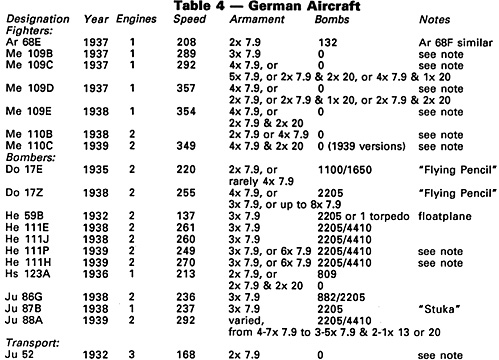
Notes
Year. The year the aircraft entered production.
Engines: Number of engines.
Speed. Maximum speed in mph (multiply by 1.61 for speed in kph).
Armament., Number and caliber (in mm) of the guns (13mm and 20mm cannon; 7.9mm machineguns).
Bombs: Bomb load in lbs (multiply by .45 for load in kg). When two numbers are given, the first is the standard load and the second is the maximum load.
Me 109: 1) The Me 109 was officially designated Bf 109. German designations were based on the initials of the aircraft manufacturer (Ar: Arado, Do: Dornier, He: Heinkel, Hs: Henschel, Ju: Junkers). The Bf 109, designed by Willy Messerschmitt, was built by the Bayerische Flugzeugwerke AG and thus was designated Bf 109. In 1938, the Bayerische Flugzeugwerke AG was renamed Messerschmitt AG, and its subsequent aircraft received "Me" designations (e.g., the Me 262 and Me 410). The Bf 109 kept its original designation in official records, but most popular sources called it the "Me 109" during the war. Europa uses its popular designation. 2) The Me 109, especially the early models, often had varying armament. The armament of the Me 109E is that of 1939; the best-known armament of 4x 7.9 and 1x 20 did not appear until the E-3 submodel in 1940. Similarly, the early Es did not carry bombs while some later variants could carry up to a 550-lb bomb load.
Me 110: 1) The Me 110 was officially designated the Bf 110; see note 1 for the Me 109. 2) Although fast, the twin-engined Me 110 had poor maneuverability, a serious handicap in air combat against high-speed single-engined fighters such as the Spitfire.
He 111: The He 111P and the He 111H models both had a profusion of submodels with varying characterisitics. Further, both the P and H models were very similar to one another, and the characteristics of a submodel of one model often matched those of a submodel of the other model. For convenience, Europa uses the He 111P model to represent the lighter-armed P and H submodels: the P-0, P-1, P-2, H-0, H-1, and early H-2; while the He 111H represents the upgunned later submodels of the P and H. This arrangement works well for game purposes, although it appears to exaggerate the number of He 111Ps in 1939-40. (Well over half the counters marked "He 111P" actually represent early-submodel He 111Hs. Conversely, some of the "He 111H" counters in Balkan Frontrepresent later He 111Ps.)
Ju 52: The full official designation of the Ju 52 was "Ju 52/3m" and was nicknamed the "Tante Ju." The "3m" meant it was the 3-motor version of the Ju 52, to distinguish it from the 1930 1-motor version, of which perhaps five were made. In the mid-1930s, a bomber version of the Ju 52 temporarily saw service in the Luftwaffe. Most these became transports when more modern bombers entered service.
Inside Europa First to Fight Designer's Notes Part II, Section B Germany [Europa 24]
- German Army Divisions and Panzer Troops
Mountain Troops and Infantry
Cavalry, Artillery, and Engineer/Construction Troops
Security Troops
The Replacement Army
Luftwaffe
Kriegsmarine
Brandenburgers
SS and SA
Table 1: 1939 German Tanks
Table 2: 1939 German Divisions: Authorized Organizations
Table 3: German Divisions: Authorized Strengths
Table 4: German Aircraft
Inside Europa First to Fight Designer's Notes Part II, Section A Germany [Europa 23]
- Introduction
Army Re-armament and Manpower
Strategic Situation
Germany-Allies Strength Comparison
German High Command and the Government
Volksdeutsch Resettlement 1939-1942
The Wehrkreis System
Frontier Defenses and Border Regt Commands
Back to Europa Number 24 Table of Contents
Back to Europa List of Issues
Back to MagWeb Master Magazine List
© Copyright 1992 by GR/D
This article appears in MagWeb.com (Magazine Web) on the Internet World Wide Web. Other articles from military history and related magazines are available at http://www.magweb.com